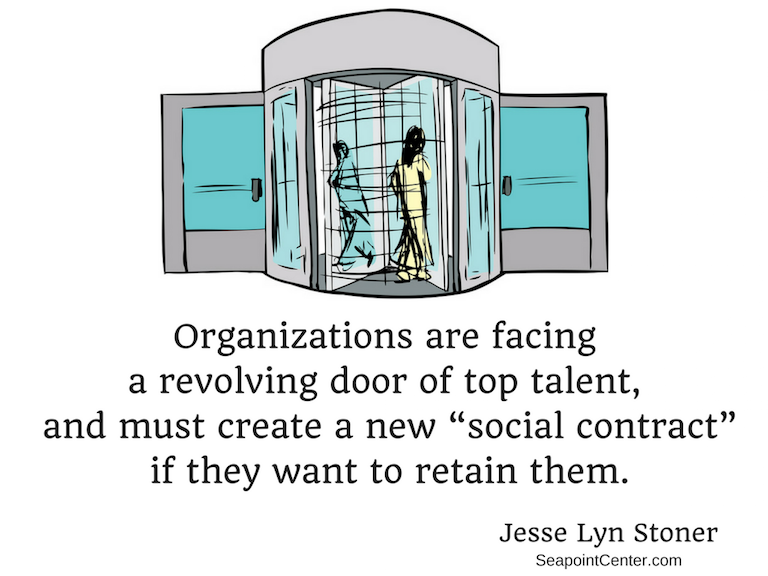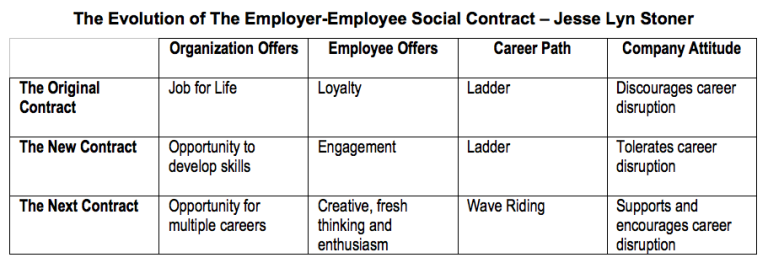 Career mobility is the new way of the future. According to a 2012 Future Workplace Study, 91% of millennials expect to stay in a job for less than three years, and Fast Company reported a study pointing toward 4-year careers.
Career mobility is the new way of the future. According to a 2012 Future Workplace Study, 91% of millennials expect to stay in a job for less than three years, and Fast Company reported a study pointing toward 4-year careers.
But are today’s organizations prepared for this kind of career mobility?
Traditionally, career paths have been based on the notion of a career ladder. Salary and prestige are based on upward movement.
As organizations now face a revolving door of top talent, they need to rethink the “employer-employee social contract..”
Transformation of the “Employer-Employee Social Contract”
The employer-employee social contract is the implied and understood psychological and social agreement about the relationship between the employee and the company. The employee gives certain things in exchange for things the company gives.
The original social contract, which governed most of the 20th century, was that in exchange for loyalty, the company would provide a job for life. However, toward the end of the 20th century, as a result of periods of downsizing where companies could no longer promise a job for life, the contract no longer held up.
In the 1990’s a new social contract emerged – that in exchange for a full effort and engagement while part of the company, the company would offer the opportunity to increase skills that could be transferred to one’s new company. But the Gallup engagement studies have clearly demonstrated the new contract no longer works, if it ever did.
In today’s increasingly complex world, where creativity and innovation are the seedbeds of growth, organizations need employees who are attuned to fresh thinking, not those who are simply showing up at the job.
The next social contract must become: In exchange for creativity, fresh thinking and enthusiasm, the company will provide an abundance and variety of learning experiences and career opportunities, so that the employee can take charge of their own trajectory.
Whitney Johnson, author of Disrupt Yourself, uses the analogy of surfing – that the employee will ride the wave as long as it works for them, and then seek the next one. Instead of climbing a ladder, employees of the future will surf the waves, from one career to another.
According to Bev Kaye, author of Up Is Not the Only Way, “Career mobility is no longer just about moving up. It’s about stretching, learning, and transforming.”

The “Next Social Contract” and Career Mobility
What does the next social contract actually look like in practice? How does it support career mobility?
Many new organizations, often led by millennials who want to surf the career waves themselves, understand how build an organization that responds to this contract. Often, especially tech companies, they are organized around competencies and agile work processes, rather than hierarchy.
But for existing organizations, nothing less than a full transformation is required. Organizations cannot just tweak what they have. This issue will not be resolved by a program.
We must completely rethink the role of careers in organizations – to throw everything we think we know about development out the window and come up with creative, fresh thinking.
Six Ways Organizations Must Transform to Address Career Mobility
Leaders must take time for reflection on how to transform their organizations. Some of the questions they need to consider are:
1. Leadership and Structure: What are the implications for what leadership looks like? How can we create an organizational structure that is not based on hierarchy and provide non-hierarchical leadership?
2. Attitudes: How does our thinking need to change? What would it mean to change from thinking about “career paths” to “career opportunities?” How can we change our norms and beliefs to view frequent job change as desirable?
3. Jobs and Roles: What kind of jobs can we offer that are meaningful, and that give employees an opportunity to make a contribution and to maximize their potential?
4. Job Titles: What job titles would reflect what people do rather than reinforce the importance of hierarchical position?
5. Compensation: What kind of pay structure would reward multiple skills rather than hierarchical position?
6. Career Development: How can we focus on competency development, not career development. How can we offer clear choices that support employees in taking charge of their own development?













I particularly appreciated your explanation of the evolution of the social contract between workers and employers. It makes sense and it was helpful to see it laid out so clearly. Thank you!
So glad to hear that. Many people are feeling dismayed because the contact changed and they didn’t realize it. This next contract is about supporting individuals as they assume responsibility for managing their own development and careers.
It is interesting that in the community human service movement of the 80s and 90s, low pay forced us into the new and even the next contract. Young people are attracted to jobs that serve people with disabilities, and we were inventing how to serve them in the community. They could only stay for a few years because the pay was inadequate. One of the best ways that I used to keep them was to offer an educational benefit and a good training program. Often bright and talented students stayed until they graduated. They also loved learning how to advocate with the Legislature on behalf of both themselves and their clients.
Interesting how community human services was on the leading edge. Development opportunities are more important now than ever. Thanks for that view, Betsy!
I appreciate this post! As a 50+ woman trying to forge her career path, it is not easy to recognize and prioritize the investments of time, money, and activities that could be most helpful in blazing my personal trail to “success.”
We are in a transition, and it is even more challenging for those over 50 searching for some security. The best investment is in creating a network.
Brilliant. And so true. I would also add that in addition to creative thinking, exploration opportunities, and developing multiple skills, today’s “handshake vs. contract” must also include a realization that employees also want a LIFE. Right now, I am heading into an organization that is losing the best and brightest because of overwork. Leaders who are drivers, who have only one speed and that is full throttle, are literally throttling the enthusiasm and life out of employees.
Another good question to add to the list: How do we offer options for work/life balance, parental leave, and leave for other life events like a death in the family. Sheryl Sandberg was recently talking about how Facebook is responding to these kinds of issues for employees.
How can we reconcile the concept of “partner” (essential for many firm’s retirement program), with the resistance of the younger generation to that concept? It frustrates companies with “partner” as a major part of their motivational lever.
It would depend what you mean by “partner.”
I’m referring to becoming a partner in a law firm or one of the big (or small) consulting firms. There seems to be a disconnect in it’s importance. What can be done to communicate the value to the younger generation? Or is the system out of touch? If the younger generation doesn’t see value, they won’t get in line. Thanks for your article. I think it reminds us that we might not be seeing the real issues involved.
That makes sense, Mick. Long-term relationship is not necessarily a goal for millennials. Universum and INSEAD conducted a global study of what millennials want from work that you might find interesting: http://universumglobal.com/millennials/
Great questions, Jesse! I love the ones on career opportunities and competency development – totally agree. The discourse and language of ‘paths’ and ‘ladders’ is beginning to change. We are all going to need the know-why and know-how to learn to leap into new opportunities with new or renewed capabilities. Unpleasant scary for some, exciting scary for others. Mindset shift and empowering yourself with the right support and challenge from allies.
Well said, David! It is definitely about a change in mindset – to empower yourself instead of depending on others to take care of you. The unknown is almost always scary. But as you point out, it can also be exciting.